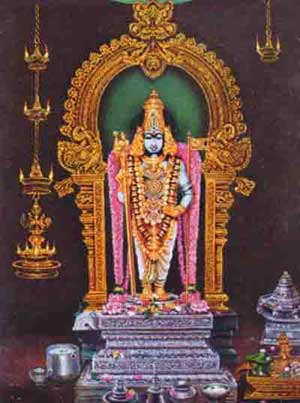|
|
|
"Yaam irukka bhayam eyn? Why fear when I am?" |

|
|
Velāyudhapāni Swami |
Glossary
-
Agni Natchatram:
The hottest part of the summer; it is forecast in the Almanac. Prayers are offered to God to lessen the intensity of the heat.
- Archana:
Specific prayer to a deity in the name of a devotee by mentioning his birth star and chanting mantras.
- Balipita:
Stone pedestal in which cooked rice is offered to the minor deities.
- Devasthānam (also spelt devastanam):
The statutory authority which manages the affairs of temple.
- Gopurams:
Gateway-towers over entrance porches, the loftiest portions of South Indian temples, of oblong shape, richly decorated with successive entablatures of statuary in stone or terra-cotta. These multi-storied pyramids built of brick and mortar, rise from a huge rectangular mass of stone masonry. The tower goes up tier upon tier, in a diminishing upward sweep. The entire surface of the gopuram is connected into a pulsating mass of gods and goddesses, angels and demons of Hindu mythology.
- Kalyana Mandapam:
An ornate pillared hall in Dravidian architectural style specially used to celebrate the symbolic marriage of the presiding deity with His consort.
- Kattiam or Kattiyak-karan:
Kattiam is the designation of a temple servant who recites certain passages at the services (pujas) and at processions of the deity. He is drawn from a particular family, by tradition, over the ages. He exercises the hereditary right and is entitled to certain courtesies. He is the A.D.C. (Aide-de-camp or bodyguard) who protects the person of the deity, by carrying with him a weapon, five feet long with a silver coating. On top of it is an emblem of the cock. His recitation is called Kattiyam Kooral or glorification of the Lord.
- Kāvadi:
An ornamental piece of semi-circular bent wood decorated with pictures of Muruga, carried by ardent devotees in fulfillment of vows with skewers stuck on body, cheek or tongue in voluntary mortification of the flesh.
- Kuriñji (Montane):
One of the five-fold regions of Tamil Nadu according to the conventions of ancient Tamil Poetry.
- Moolavar:
Presiding deity or Stationary idol. This is not used in processions. The idol used in processions, the portable deity, is made of panchalogani or five metals:
gold, silver, copper, iron and lead.
- Palli Arai:
Literally this means the bedroom where the Lord sleeps with His spouse. In the hill temple it simply means a rest-room, for the Lord is an ascetic, all by Himself. The cradle that doth rock our childhood here doth also rock divinity.
- Parijarakar:
This is the designation of Brahmin gurukkals of the hill temple. They alone are entitled to enter inner precincts of the sanctum sanctorum, to touch the deity, perform the Abhishekams, to dress the deity and to illuminate with artistry an infinite variety of beautiful and exquisite lamps to enable the worshippers to see the image of the Lord. (There is no electricity in the sanctum sanctorum; light comes only from the wicks burning in the oil lamps and from camphor lit at the services). The existence of these lamps helps man to shed the fear of darkness.
- Parivattam:
Temple honours accorded to donors and to V.I.P.s. A gold-laced cloth presented to the individual or individuals, on behalf of the Devasthānam with the Lord's blessings, is tied to the donor's head like a turban by the chief priest on duty. The donor is garlanded to the sounds of Nagaswaram. Holy ash, kumkuma, sandal paste, panchāmirtam, appam, murukku and laddu are handed to him with due pomp and ceremony.
- Prakaram:
Open courtyard or enclosed precincts of a temple, meant for circumambulation by the worshipper and for taking out processions of the deity.
- Prasādam:
An edible, first offered to the deity and later distributed to the devotees.
- Pujas:
Temple services at the prescribed hours every day.
- Sannidhi:
The space in front of the presiding deity. The devotees gather here to get a close-up view.
- Sathavaraja Panditar:
Designation of the High Priest of the hill-temple.
- Siddhars:
Men of vision who are masters in the use of herbs.
- Sthala Puranam:
History and legend pertaining to a place of pilgrimage.
- Tīvatti:
There are two tīvattis, carried in front of the deity one to His right and other to His left, to illuminate the route of the divine procession in the hill-temple. Even after the advent of electricity, this time-honored torch of flames continues to be in use. In addition, petromax lights are carried in the procession and have been found handy and useful, when power fails all of a sudden. The tīvatti is a metallic piece 35" long. Its bottom portion or handle is heavy and is in silver. The top portion is a round rod at the tip of which flame emanates from cloth soaked in ghee (melted butter).
The tīvatti is borne by the devotees who consider it a privilege to do such service to the Lord. The opportunity is available only to two persons each night, at the deity's march to the Palli Arai. A fee is collected from these devotees. Registration is done on a first-come first served' basis by the Superintendent or the Peishkar at the hill.
- Vel:
The Vel or sacred spear is the most powerful weapon in Muruga's armory. It is sanctified through special pujas and abhishekams and is believed to be charged with Divinity. It is the Sceptre of Power, the Axis Mundi. Spears for new temples for Muruga are made as prototypes of the one held by Lord Dandāyudhapāni at Palani and before installation, they are brought to Palani and placed at the sanctum sanctorum of Lord Dandāyudhapāni for a prescribed period.
- Vimānam:
A tower over the sanctum sanctorum. The architectural counterpart of the vimāna is the spire of a Gothic church.
|

